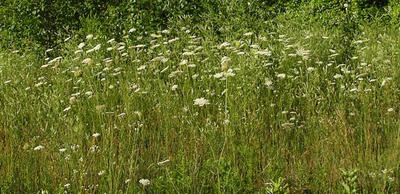The weather has turned--still hot, but the humidity is much decreased. The yard was one busy place this morning. A family of great crested flycatchers is hanging around. Adults calling, fledglings begging, everyone flying from tree to shrub to tree.
The honeysuckles are full of robins, adults and young, and we have some eccentric singers among them. Our local naturalist, Terry Sprague, has written about the problem of dialect differences among birds, i.e., the problem it poses for birders, but he is comfortable distinguishing birds by "tone of voice." I am only really familiar with a few birds' tones, but I am finding at this point on the learning curve I hear much more and am confident of less. So I am out in the yard frequently through the day to see if that really is a robin I hear. What I don't know is if all the funny songs I am hearing are being sung by adults. Maybe the young try out their songs in their first summer?
There is a family of rose-breasted grosbeaks in the mix, and while I usually know this bird's song, it (and a host of others I am just learning) have enough similarity to the robin that again I must check, check, check. The begging call of the grosbeaks is also quite similar to that of the great crested flycatchers--different tone, similar pitch and duration--at least that's how it seems to me.
Even the wrens are creating an epistemological problem for me today. Perhaps because there are wrens in both birdhouses, which I haven't experienced before, either one of them is singing its song almost upside down, or there's a mystery bird out there too--always a live possibility. Right now, through the window, I can hear the mew of a flicker, I think, but it may also be a yellow-bellied sapsucker. Both hang around here--and sometimes by this time of year I'm in birdsong overload, and really need to check everything I hear.
With all this action in the yard, not even mentioning the sparrows, goldfinches, catbirds, common yellowthroats and chickadees (and whoever else I'm leaving out), and the first pleasant morning we've had in long time, I was anxious to get out on the walk.
To my surprise there was very little going on in the fields. I saw one kingbird, some unidentified sparrows, a mourning dove, and of course heard the ubiquitous wrens. Also singing, a field sparrow, and just as I was heading back the common yellowthroat in the cedar bush started up. Maybe if I'd lingered I'd have heard and seen more--I really want to see that Brewster's warbler carrying food (which would confirm it as a breeder for the Breeding Atlas). But I kinda rushed through because of the one species that was very active and very numerous today. From the time I hit the scrape, all through the far field and most of the way back home I was being buzzed by 10 or 15 deer flies. This is more than I've ever seen before at one time here. I wasn't bitten--perhaps like blackflies these were species-specific biters but omnivorous buzzers--but they made it very difficult for me to relax and stand in one spot for any length of time. The mosquitoes, on the other hand, were much less numerous than they have been recently, even in the cedar bush.
As striking as the number of deer flies in the fields was the change of colour. Where purple dominated just a little while ago (clovers, bugloss, and above all curly vetch) now white has taken over. The sweet clover, a tall clover with clusters of small white flowers and the Queen Anne's lace are just coming in to their own.
Our Favorite Birds (Collaborative Post)
19 hours ago







No comments:
Post a Comment